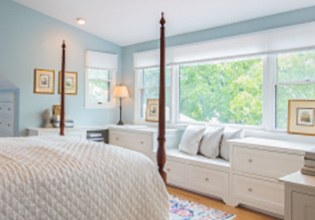General Remodeling & Wentworth-Specific FAQs
1) When is the best time to remodel my home?
Home remodeling is performed on a year-round basis with most work, which involves reconfiguration of the interior spaces, not significantly impacted by the weather. However, below are three tips that can be your guide when remodeling your home, with special consideration given to weather conditions:
- If a homeowner is considering an addition to his or her home, the footing/foundation concrete/masonry work would ideally be done when the earth is not frozen and temperatures are above freezing. In the Washington, DC metropolitan area, this often means avoiding footing/foundation work in January and February. And, yet, there are additives that can be mixed with the concrete and mortar to compensate for freezing temperatures to allow cold weather work. Once a foundation is in place, the framing and other necessary construction can commence despite cold or hot weather. A serious blizzard, hurricane or rainstorm might slow work progress, but are manageable despite schedule setbacks.
- If a homeowner’s remodeler is removing the roof to build a second floor, it is beneficial to do the work when there is less rain and snow, which means summer and fall. Once the new addition is framed, enclosed, and made weather-tight with roofing and windows, the interior work can commence uninterrupted by weather conditions.
- Being without a place to cook during a kitchen remodel can be stressful. This is why some homeowners opt to renovate their kitchen before or after the winter months so that they can use an outdoor gas grill to cook their meals rather than eating every meal in a restaurant.
2) How can I find a dependable design/build remodeling company?
Experience, credentials, and reputation matter. Below are several points that will help you decide if a company is a good fit for your project.
- Ideally the design/build firm will have its architectural design and carpentry services in-house. This way a company will have more control over its staff for quality control and schedule. It is impossible to have significant influence over design or carpentry staff that is subcontracted.
- Verify that the remodeling company is really licensed as a home improvement contractor and architect in your jurisdiction. In the DC area, that means licenses in Maryland, Washington, DC, and Virginia.
- References are always smart and helpful. You should contact a few of the remodeling company’s past clients and learn about their experience. Are they happy with the results? In some cases, you might be able to visit a job site, as long as it is not intrusive on the homeowner.
- Set up a meet and greet at the remodeling company’s office so you can be introduced to some of the people you will be working with and to check out the office environment. You will quickly learn if it’s a good fit.
3) How did the idea for Wentworth originate?
Our founder, Bruce Wentworth, has always loved residential architecture and directed his career in this way. He established his architectural practice on Capitol Hill in 1986 to focus on residential design shortly after becoming a licensed architect. The abundance of homeowners with older houses in the Capitol Hill historic district made it evident that there was a need for remodeling expertise.
In the 1980s, architects were not so frequently involved in home remodeling as they are now. Bruce felt that homeowners deserved better design than contractors were providing. In addition, he felt that that homeowners would benefit from a more thorough package of services. It was here that Bruce began to study the (then) new concept of design/build. A package of services including residential architecture, the selection of products, materials, and interior finishes, as well as the actual construction made practical and cost-effective sense for residential remodeling.
4) How many years of experience does the Wentworth team have?
Bruce Wentworth became a licensed architect and a member of the American Institute of Architects (AIA) in 1985. He founded his professional architectural practice in 1986 and has been focused on home remodeling for more than 30 years. Wentworth’s design studio manager, Michael Merschat, AIA, has more than 15 years of experience in residential design. Steven Barnard, Wentworth’s production manager, oversees the carpenter crew. He has been involved in custom carpentry and construction for more than 30 years, ranging from whole house construction to finely detailed custom millwork. Wentworth’s lead carpenters have at least 10 years of carpentry experience.
5) What is the style of Wentworth?
The Wentworth design team prides itself on a varied design palette. Wentworth designs range from traditional to transitional and from sleek and modern, but the design is always influenced by the client’s aesthetic and functional requirements as well as the home’s design needs. Clients are asked to prepare “idea books” for their projects (often from Houzz, Pinterest or simply magazine clippings) that our design studio staff uses to guide the design phase. Wentworth’s skilled architects and designers will work in the appropriate design style that solves the homeowner’s design problem. Wentworth is also known for “sensitively designed home additions.” In other words, additions and exterior remodeling work that looks like they belong to the original house in terms of scale and detail; home additions and façade remodeling work that doesn’t look “tacked on.”
6) What sets Wentworth apart from other design/build firms in the area?
Architect-led design/build sets Wentworth apart from other remodeling firms in the Washington, DC metropolitan area. Few design and remodeling firms are owned, operated, and led by a licensed architect with a passion for residential design. Wentworth clients get the benefit of thoughtful designs and bespoke construction. In contrast to Wentworth’s passion for design, the typical design/build firm comes to their work as builders who are less concerned about design. In fact, most design/build firms do not have architects on staff. At Wentworth, we start with serious design options and explore alternatives. Our design expertise, along with zoning and historic district experience, sets us apart from the pack of contractor-led design/build companies. And, with our attention to service and detail, our clients love their completed projects.
7) If I have general ideas, can Wentworth establish which ideas will work best for my project?
We feel it is very important to know and understand our clients general design ideas. After all, our clients live in and know their homes better than anyone else. Our initial meeting with a homeowner always starts with learning about their project’s goals and priorities. Homeowners know how they live in their house and can provide important insights into what home improvements will make their life functionally and emotionally better. It has been our experience that a client’s initial general design ideas can be developed for a design presentation and are one among three or four ideas presented for a client’s evaluation. So don’t be shy about expressing your ideas for the remodeling project.
8) Once I decide to work with Wentworth, what is the general process of the remodel?
You can visit our Architecture Process page to learn more about this.
9) Can I request or change things during the remodel?
The Wentworth process allows our design team and the homeowner to explore design options and work out the many details before construction starts. Having all the details documented and clarified in our construction drawings allows Wentworth to provide clients with fixed-price construction contracts. In the event that a change is required, either client driven or by an unforeseen condition, it is easily handled with a standard form we call “Change of Plans” (COP). We encourage our clients to have minimal changes in order to avoid project delays or cost overruns.
10) If you had one piece of advice for homeowners looking to remodel, what would it be?
A homeowner with a realistic budget and appropriate timeframe will find the design/build endeavor more pleasant. And, in terms of investing in a home, if a client is undertaking a major remodeling project (perhaps in the range of $100,000 – $400,000) it is best to plan to stay in their house 10 – 20 years to reap the benefits. A home cannot be treated as a real estate investment; it is a home. Short-term real estate investors should find an alternate path for their remodeling projects.







